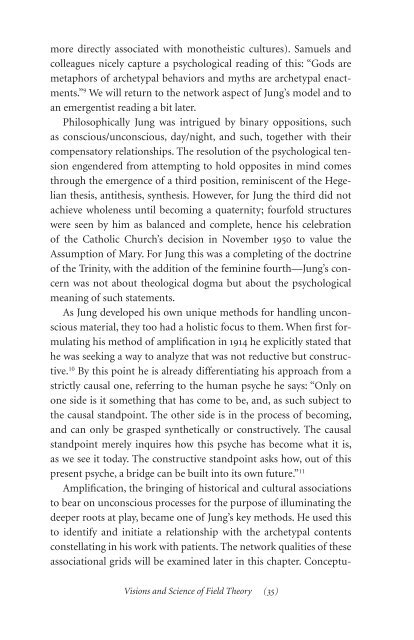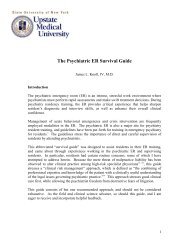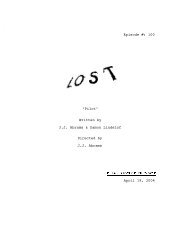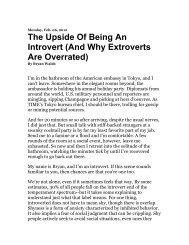Synchronicity Cambray
Synchronicity Cambray
Synchronicity Cambray
You also want an ePaper? Increase the reach of your titles
YUMPU automatically turns print PDFs into web optimized ePapers that Google loves.
more directly associated with monotheistic cultures). Samuels and<br />
colleagues nicely capture a psychological reading of this: “Gods are<br />
metaphors of archetypal behaviors and myths are archetypal enactments.”<br />
9 We will return to the network aspect of Jung’s model and to<br />
an emergentist reading a bit later.<br />
Philosophically Jung was intrigued by binary oppositions, such<br />
as conscious/unconscious, day/night, and such, together with their<br />
compensatory relationships. The resolution of the psychological tension<br />
engendered from attempting to hold opposites in mind comes<br />
through the emergence of a third position, reminiscent of the Hegelian<br />
thesis, antithesis, synthesis. However, for Jung the third did not<br />
achieve wholeness until becoming a quaternity; fourfold structures<br />
were seen by him as balanced and complete, hence his celebration<br />
of the Catholic Church’s decision in November 1950 to value the<br />
Assumption of Mary. For Jung this was a completing of the doctrine<br />
of the Trinity, with the addition of the feminine fourth—Jung’s concern<br />
was not about theological dogma but about the psychological<br />
meaning of such statements.<br />
As Jung developed his own unique methods for handling unconscious<br />
material, they too had a holistic focus to them. When first formulating<br />
his method of amplification in 1914 he explicitly stated that<br />
he was seeking a way to analyze that was not reductive but constructive.<br />
10 By this point he is already differentiating his approach from a<br />
strictly causal one, referring to the human psyche he says: “Only on<br />
one side is it something that has come to be, and, as such subject to<br />
the causal standpoint. The other side is in the process of becoming,<br />
and can only be grasped synthetically or constructively. The causal<br />
standpoint merely inquires how this psyche has become what it is,<br />
as we see it today. The constructive standpoint asks how, out of this<br />
present psyche, a bridge can be built into its own future.” 11<br />
Amplification, the bringing of historical and cultural associations<br />
to bear on unconscious processes for the purpose of illuminating the<br />
deeper roots at play, became one of Jung’s key methods. He used this<br />
to identify and initiate a relationship with the archetypal contents<br />
constellating in his work with patients. The network qualities of these<br />
associational grids will be examined later in this chapter. Conceptu-<br />
Visions and Science of Field Theory ( 35 )









